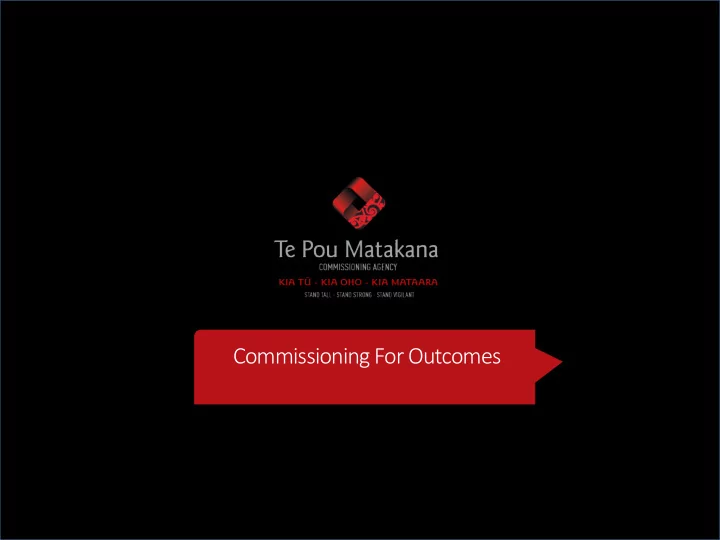

Commissioning For Outcomes
Our commissioning model
Our role in the Whānau Ora chain
Our TPM Wh ānau Ora Partners 13 Partners leading out Collective Impact initiatives • 13 unique initiatives supporting wh ānau • Over 100 organisations
Our TPM Wh ānau Ora Partners 13 Partners leading out Collective Impact initiatives • 13 unique initiatives supporting wh ānau • Over 100 organisations Over 60 Kai ārahi Providers Over 30 Wh ānau Direct Providers
Shared Outcomes Framework and TPM Outcomes Roadmap
TPM Outcomes Roadmap – Overview The TPM Outcomes Roadmap is an operational document that outlines a set of practical steps that TPM can take to refine and improve its Outcomes Framework over FY15/16 and beyond. It provides a set of tools and processes that will enable TPM to collect the data needed to: Prove that TPM is having the impact it intends to have; and Improve its outcomes for whānau.
TPM Outcomes Roadmap – Key action areas 1. Logic Models TPM has approved two logic models. 2. Outcome domains, outcomes & indicators TPM has endorsed six outcome domains outlined in Sir Mason Durie’s TPM Outcomes Framework. Whānau Outcomes Menu to be developed with TPM Partners, and define a set of possible indicators Finalise a set of indicators that corresponds to the 12 outcomes in the TPM commissioning model 3. Measurement and Assessment approach TPM will move to a measurement and assessment approach that is consistent across all three commissioning activities and can evolve and improve over time. The approach will draw on four key tools – Tool A: a consistent whānau engagement, planning and outcomes assessment tool – Tool B: a flexible outcomes reporting tool (drawing on the Whānau Outcomes Menu) – Tool C: a biannual survey for whānau – Tool D: a biannual survey for Partners
Commissioning Logic Model
Measurement Tools – Planning & Outcomes Assessment Tool
Measurement Tools – Wh ānau Outcomes Reporting Tool Whānau Outcomes Outcome Domain Possible Indicators Whānau Priority Outcome • Improve my eating patterns Improved Diet & Whānau Health Whānau have plans and and increase my physical Healthier Lifestyles achieve goals for their health • activity Whānau are eating 5+ fruit and vegetables per day • Whānau have increased 'exercise hours' per week • Make sure my tamariki are Improved Child Whānau Health Well Child Tamariki Ora Core growing up healthy Development Contacts completed • Immunisations up to date • B4S Check Completed • Make sure my tamariki are Improved School Whānau Knowledge Participation in ECE • ready to go to school Readiness B4S Check Completed • Manage my stress and daily Improved Mental Whānau Health Mataora Assessment - life better Health improvement in need • Stress/self management programme completed • Manage my money better Increased financial Whānau standards Financial budget in place • and not rely on others literacy of living Increase in savings • Improvement in employment situation
Outcomes, indicators and data collection for commissioning activities
Whānau Direct Wh ānau Assessment and Wh ānau Direct Application: What is the wh ānau situation? What is the proposed solution to improve the whānau situation What is the expected immediate change? Linked to which TPM Outcome Domain? What would you expect to see improved or reduced with this change? Without this resource what would happen? Wh ānau Check In: Was the expected immediate change achieved? Reason(s) for achieving (or not achieving) the change? What was the result of the expected improvement or reduction? What was the impact on the wh ānau situation? What was the wh ānau’s experience with Wh ānau Direct?
Whānau Engaged 2,973 whānau engaged through Whānau Direct 3,400 outcomes identified by whānau 3,264 outcomes achieved by whānau
Evaluation Independent Evaluation completed by Dr Chelsea Grootveld “Has made a positive immediate difference to whānau” “The flow on and ripple effect of a small intervention is huge for whānau. It empowers whānau, enables self -autonomy and independence. The positive change is reflected in positive whānau feedback.” – Whānau Direct provider “This has given me the kick start I needed to get my business up and running. I want to be more independent and share my skills with others.” – 25 year old solo mother of 4 children wanting to set up a small business “The impact has been huge and has made an immense difference in my life.” – 76 year old kaumātua with chronic respiratory illness and diabetes
Social Calculator A tool to demonstrate the benefits of Whānau Direct. It attempts to: Demonstrate the benefit of Whānau Direct versus the cost of government intervention. It does this by asking: “What would have likely happened for whānau if we had done nothing?” “What government agency would have become involved with whānau and what would be the minimum cost of this?” In estimating the cost of the government intervention we have leveraged the experience of our Partners working with whānau to identify the likely government agency involvement, the probability of that involvement, and the extent of that involvement (in hours).
Recommend
More recommend